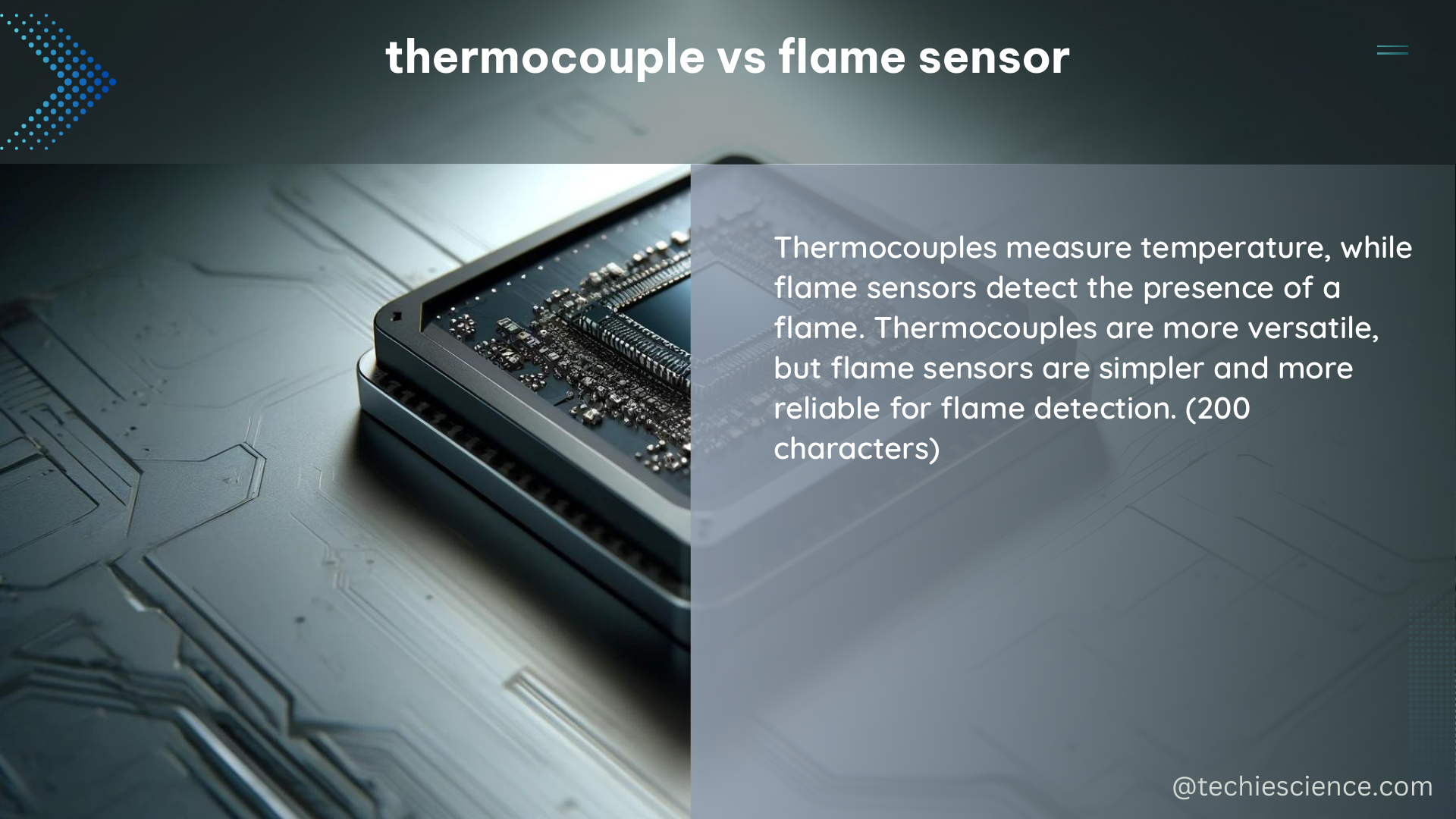Thermocouples and flame sensors are both temperature measurement devices, but they operate on different principles and have distinct applications. This comprehensive guide will delve into the technical details, advantages, and use cases of these two sensor types, providing DIY enthusiasts with the knowledge to make informed decisions and build their own temperature monitoring systems.
Understanding Thermocouples
Thermocouples are temperature sensors that measure the temperature difference between two junctions of dissimilar metals. When these junctions are exposed to different temperatures, a small voltage is generated, which is proportional to the temperature difference. This voltage can be measured and converted into a temperature reading.
Technical Specifications of Thermocouples
- Temperature Range: Thermocouples can measure temperatures ranging from -200°C to 2000°C, depending on the type of thermocouple used. Common types include Type K (-200°C to 1372°C), Type J (-210°C to 1200°C), and Type T (-200°C to 400°C).
- Response Time: Thermocouples have a fast response time, typically less than 1 second, making them suitable for applications that require rapid temperature monitoring.
- Accuracy: Thermocouples can achieve an accuracy of ±1°C to ±2°C, depending on the type and calibration.
- Durability: Thermocouples are known for their durability and can withstand harsh environments, such as high temperatures, corrosive atmospheres, and mechanical stress.
- Cost: Thermocouples are relatively inexpensive, making them a cost-effective solution for temperature measurement.
DIY Thermocouple Construction
Building a thermocouple for DIY projects is a straightforward process. All you need are two dissimilar metal wires, such as copper and constantan, and a multimeter to measure the generated voltage. The voltage can then be converted to a temperature reading using the appropriate thermocouple calibration curve.
Understanding Flame Sensors

Flame sensors are devices that detect the presence of a flame by sensing the heat and light emitted by the flame. They are commonly used in gas appliances, such as furnaces, water heaters, and boilers, to ensure that the flame is present and burning safely.
Types of Flame Sensors
Flame sensors can be categorized into two main types:
- Thermal Flame Sensors: These sensors detect the heat emitted by the flame and are typically used in applications where the flame is in direct contact with the sensor.
- Optical Flame Sensors: These sensors detect the light emitted by the flame and are often used in applications where the flame is not in direct contact with the sensor.
Technical Specifications of Flame Sensors
- Temperature Range: Thermal flame sensors can measure temperatures up to 1300°C, while optical flame sensors can measure temperatures up to 5000°C.
- Response Time: Flame sensors have a very fast response time, typically less than 10 milliseconds, allowing them to quickly detect the presence or absence of a flame.
- Accuracy: Flame sensors have an accuracy of ±5% to ±10%, depending on the type and application.
- Durability: Flame sensors are designed to withstand the harsh environments found in gas appliances, such as high temperatures and corrosive atmospheres.
- Cost: Flame sensors are relatively inexpensive, making them a cost-effective solution for flame detection in gas appliances.
DIY Flame Sensor Construction
Building a flame sensor for DIY projects can be done using off-the-shelf components. There are various DIY kits available that include the sensor, a microcontroller, and a display, making it easy for hobbyists to create their own flame detection systems.
Comparison of Thermocouples and Flame Sensors
While both thermocouples and flame sensors are temperature measurement devices, they have distinct differences in their principles of operation, applications, and technical specifications.
| Feature | Thermocouple | Flame Sensor |
|---|---|---|
| Principle of Operation | Measures temperature difference between two junctions of dissimilar metals | Detects the presence of a flame by sensing the heat and light emitted |
| Temperature Range | -200°C to 2000°C | Up to 1300°C (thermal) or 5000°C (optical) |
| Response Time | Less than 1 second | Less than 10 milliseconds |
| Accuracy | ±1°C to ±2°C | ±5% to ±10% |
| Durability | Highly durable in harsh environments | Designed for harsh environments in gas appliances |
| Cost | Relatively inexpensive | Relatively inexpensive |
| Common Applications | Industrial processes, furnaces, boilers, chemical plants | Gas appliances, furnaces, water heaters, boilers |
Conclusion
Thermocouples and flame sensors are both valuable temperature measurement devices, but they serve different purposes and have unique characteristics. Thermocouples are ideal for measuring temperature differences in industrial applications, while flame sensors are essential for detecting the presence of a flame in gas appliances.
By understanding the technical specifications and construction methods of these sensors, DIY enthusiasts can build their own temperature monitoring and flame detection systems, tailored to their specific needs and projects. This comprehensive guide provides the necessary information to make informed decisions and create effective temperature measurement solutions.
References
- A Review on Biosensors and Recent Development of … – MDPI
- ENERGY SAVINGS TOOLBOX – An Energy Audit Manual and Tool – Natural Resources Canada
- 40 CFR Part 63 Subpart A — General Provisions – eCFR
- Recommended Practices for Measurement of Gas Path Pressures … – DTIC
- Sensors for daily life: A review – ScienceDirect.com

The lambdageeks.com Core SME Team is a group of experienced subject matter experts from diverse scientific and technical fields including Physics, Chemistry, Technology,Electronics & Electrical Engineering, Automotive, Mechanical Engineering. Our team collaborates to create high-quality, well-researched articles on a wide range of science and technology topics for the lambdageeks.com website.
All Our Senior SME are having more than 7 Years of experience in the respective fields . They are either Working Industry Professionals or assocaited With different Universities. Refer Our Authors Page to get to know About our Core SMEs.